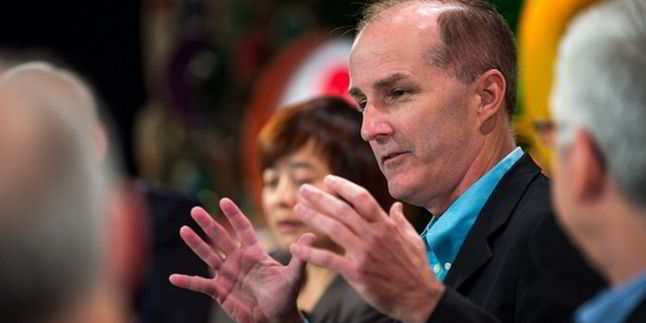In comments made at the opening session of Solar Power International in Las Vegas on Monday, the plainspoken Crane – seen as a visionary in some energy circles – doubled down on his belief that the biggest opportunity in the energy business lies in distributed solar, a view which contributed considerably to his firing at NRG.
Under Crane’s maverick leadership from 2003 to 2015, NRG, which owns 50GW of generating capacity, transformed from a coal-centric power generator into a major player in US renewables, making huge investments into utility-scale wind, PV and CSP – albeit while maintaining a heavy presence in fossil fuels.
In 2012 NRG launched the US renewables industry’s first yieldco, NRG Yield.
But NRG’s headlong rush into distributed solar – centred on its 2014 acquisition of Roof Diagnostics Solar – led the company’s more conservative-minded investors to conclude Crane was moving too fast, helping to send its shares into a tailspin that ended in Crane’s firing in late 2015.
In April Pegasus Capital Advisors, a New York-based private equity firm that looks for opportunity in global resource scarcity, including energy, hired Crane as its senior operating executive.
On the stage at SPI, Crane acknowledged that by the end of his time at New Jersey-based NRG he had become “a solar guy running a coal-fired power company”.
“Fundamentally what we were doing was taking the profit from the coal plants and ploughing them into solar,” he said.
Despite having deep experience in a range of renewables technologies, Crane believes solar has the brightest future in the US. “Sometimes people say, ‘Hey, you’re into renewables.’ No, I’m not into renewables – I’m into solar,” he said.
“I don’t actually believe all renewables are created equal. I think solar has all sorts of positive qualities that other forms of renewables do not have.”
From an investment standpoint, “I see significantly more opportunity on the commercial and industrial side and residential side than on the utility-scale side”, he added.
For all the momentum distributed solar has in the US – residential installations rose 29% in the most recent quarter – Crane suggested that rooftop PV leaders like SolarCity, Vivint Solar and Sunrun should have spent more time honing their business models as private companies.
Those companies went public in 2012, 2014 and 2015, respectively, and the share prices of all three have fallen brutally over the past year. That leaves them vulnerable to takeovers, including, potentially, from private-equity investors.
“The opportunity for private equity in this space right now is like nothing I’ve ever seen,” Crane said.
Tesla Motors’ offer to acquire SolarCity is subject to a shareholder vote later this year.
Explaining the apparent disconnect between the seemingly bright future of distributed solar and the depressed share prices of its leading companies, Crane said: “In retrospect, the mistake was too many companies went public too early.”
“It would have been better if there was more room for the business model to evolve as non-public companies.”
SolarCity, for one, has in recent years launched one solar loan product only to bin and replace it with another; broken ground at a 1GW solar factory in upstate New York; and lowered its installation guidance repeatedly.
“One thing I can say, having run a public company, is public markets – much more than private equity – don’t like lurches in strategy,” Crane said. “They don’t even like exponential growth; they want something entirely predictable.
“Predictability is really important [for a public company]. And in this industry, predictability’s hard to come by.
“That’s why I think there’s enormous opportunity for private equity.”

